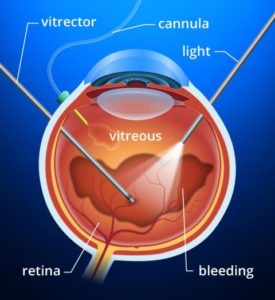If I get vitrectomy surgery to fix a retinal detachment, will I regain my vision fully?
It depends. If the center of the retina was damaged or if the detachment was only treated in a later stage, complete visual recovery cannot be guaranteed. But, there is a chance that your vision will gradually improve.
Will I have any side effects from the silicon oil in my eye?
A few patients might experience double vision. This improves after the oil is removed (3-6 months after surgery).
What will happen if the silicon oil is left in the eye?
There is a high chance that cataracts will form. The eye pressure can also increase, causing nerve damage and eye pain.
Can I have a gas injection? I don’t want silicon oil because I have to get another surgery to remove it.
That decision can only be made by a surgery. Based on the condition of your eye, one option might be better than the other. It is better to use the filling that is best for your eye health than to try and avoid another surgery.
What will happen if I choose to not get the surgery?
The retinal detachment will progress. You may lose your vision completely as the retina becomes more damaged. You can also develop cataract. If you have uveitis or glaucoma, you may experience eye pain. In the long run, your eyes might even shrink. Surgery offers a chance to improve your sight. Without it, your eyes will only get worse.
How many days will I stay in the hospital?
You will stay for 2-3 days after the surgery.
How many days will I have to tilt my head and lie on my stomach?
For 7-15 days.
How long will I spend in the recovery area after surgery?
This will vary depending on how you feel and the duration of the surgery. At Aravind, patients usually spend 1-3 hours in the recovery room.


